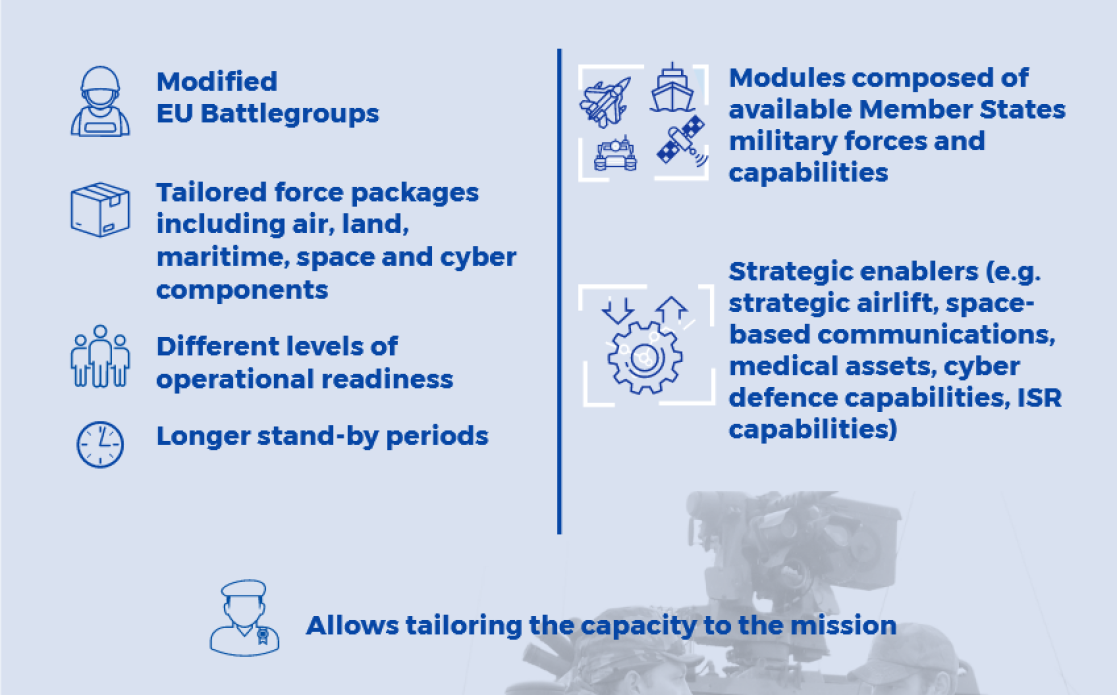EU Rapid Deployment Capacity

What is the EU RDC for?
The EU RDC will improve the ability of the EU to respond to imminent threats or quickly react to a crisis situation outside the Union at all stages of the conflict cycle. It is designed for the whole spectrum of crisis management tasks covered by the Treaty of the European Union and respective Council Conclusions in the area of Security and Defence. Collective Defence, however, is not a task for the EU RDC.
What is the relation between the EU RDC and EU Battlegroups?
The EU Battlegroups are one element of a wide variety of EU instruments and capabilities to ensure the safety of European citizens and contribute to maintaining international peace and security. They have been fully operational since 2007. Despite never being deployed, the EU Battlegroups have proven their value as a tool for defence cooperation and transformation as well as for interoperability.
The EU RDC will consist of substantially modified EU Battlegroups and of pre-identified Member States’ military forces and capabilities (modules). Therefore, the EU Battlegroups will be an integral part of the wider EU RDC framework.
Why a capacity and not a force?
The natural tendency is to think in tangible elements. In the military context most people can picture a force, but the term capacity is less common. The EU RDC is a capacity, meaning that it not only consists of force-generated elements on standby, the EU Battlegroups plus their required Strategic Enablers, but also pre-identified modules. The elements in standby are required to ensure the aspired rapidness, whereas the modules provide flexibility and economy of force. The modules allow tailoring the EU RDC to the mission in a very flexible manner. Since the EU Member States’ military forces and capabilities are pre-identified for the modules, the targeted force sensing and force-generation in case of a crisis will be much quicker.
Why is the EU RDC a Framework?
As mentioned before the EU RDC is not a mere force. There are a variety of important elements that must be developed, further developed or brought to fruition in order to fully enable the EU RDC. One example are the Operational Scenarios and Advance Planning, which will allow preparing for potential crises. Another example is utilisation of the mechanisms developed in the PESCO project EUFOR CROC to derive the modules from the Operational Scenarios. A third example are the Support Structures for the EU RDC, which will also be derived from the Operational Scenarios and Advance Plans. A fourth and final example are the regular live exercises that will contribute to the readiness and interoperability. These and many more elements are part of the wider EU RDC framework. They need to function together like cogs in a gearing to generate the required power.

Will the whole Framework be deployed?
No crisis will be like the other and the role of the military in the wider EU Integrated Approach might differ as well. Therefore, the flexibility provided by a capacity is required. The EU RDC framework allows preparing for a range of potential crises in different regions of interest to the EU. However, not every crisis might require an EU Battlegroup or all forces and capabilities in the modules. The EU RDC allows to tailor the force to be deployed, The Rapid Response Force, to the mission.
What is the state of play?
Together with all stakeholders the conceptual development of the EU RDC began already during the drafting phase of the Strategic Compass and has, in the meantime reached its final stages. The concept was discussed at the meeting of the EU Chiefs of Defence end of October and has been finalised (not yet agreed) in EUMC Working Group end of January.
In parallel to the conceptual development, several of the aforementioned elements of the EU RDC framework are in the implementation phase. The strategic environment necessitates a rapid advancement in order to meet the task of the Strategic Compass by 2025, and an EU RDC, allowing for the swiftly deployment of a modular force of up to 5,000 troops in a security environment up to and including non-permissive environment, to be fully operational.
No crisis will be like the other and the role of the military in the wider EU Integrated Approach might differ as well. Therefore, the flexibility provided by a capacity is required. The EU RDC architecture allows preparing for a range of potential crises in different regions of interest to the EU. However, not every crisis might require an EU Battlegroup or all forces and capabilities in the modules. The EU RDC allows to tailor the force to be deployed, The Rapid Response Force, to the mission.

What is the state of play?
Together with all stakeholders the conceptual development of the EU RDC began already during the drafting phase of the Strategic Compass and has in the meantime reached its final stages. The concept has been finalised in the Working Group of the EU Military Committee and was discussed at the meeting of the EU Chiefs of Defence end of October.
In parallel to the conceptual development, several of the aforementioned elements of the EU RDC architecture are under development. The strategic environment demands to continue to advance quickly in order to meet the task of the Strategic Compass that by 2025, an EU RDC, allowing the swiftly deployment of a modular force of up to 5000 troops in a non-permissive environment, will be fully operational.





